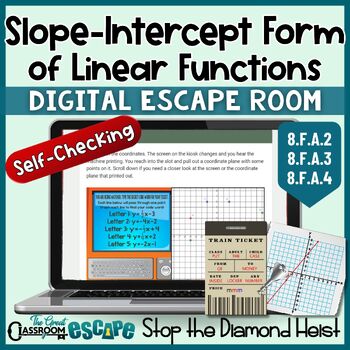Slope Intercept Form Activity Digital Escape Room Linear Functions Math Game
- PDF
- Google Apps™

What educators are saying
Description
Can your students use their knowledge of slope-intercept form of linear functions to recover the diamonds stolen in a heist? Practicing and reviewing the components of y=mx+b has never been so engaging! Students will race to create linear equations, graph lines, and solve word problems involving linear functions in this fun online breakout activity. Teachers will love how easy this activity is to implement! There are no clues to print or hide, and the entire breakout process is automated by a Google Form™ (note that you don't have to have Google™ accounts to complete this activity). The activity is completely self-checking!
Escape rooms are a great way to review before tests, provide extra practice in a more engaging way than worksheets, and provide enrichment. It is recommended that students complete this digital escape room in small groups. Some of the puzzles require students to think outside of the box as they interpret the clues to enter their answers in the proper format.
While this escape room was designed with 8th grade math standards in mind, it can also be used to review graphing linear functions at the high school level. This is a fun way for students to review basic algebra skills before they move onto graphing and transforming other types of functions in the coordinate plane.
Distance Learning Tools Included! A digital copy of the coordinate plane from the student printable page is included. Please note that in order for students to edit this page, they must have their own Google Drive™ and be able to use Google Slides™. Students do not need a Google Drive™ to complete the escape room.
In order to solve the puzzles in this digital breakout, students must be able to:
- Write an equation for a line shown on a graph using y=mx+b form
- Determine the slope (rate of change) for linear functions in different formats including from an equation, a table, and a graphed line
- Create a linear equation in slope-intercept form from a word problem with two variables. Understand the meaning of the y-intercept (initial value) and rate of change.
- Graph lines with accuracy when given an equation in slope-intercept form
- Read carefully and use critical thinking skills to solve puzzles
What's included in the PDF?
- Quickstart guide
- Detailed instructions & tips
- One page that it is recommended to be printed for each group working on the breakout. This includes tools to help solve some of the puzzles, and a QR code to access the Google Form™. Please note that a Google Slides™ version of these tools is available to help with distance learning!
- URL to access the Google Form™.
- Detailed answer key
- Success signs to snap photos with after completing the activity (optional)
- Optional link for Google Drive™ users to create a copy of the form to save to their own drives in order to view student results.
FAQ
- Do students need to have Gmail™ accounts? NO! Anyone with internet access and a tablet, computer, or even phone can complete the breakout.
- How long will this take? That is the hardest question as the answer varies depending on each classroom, student, or group. Most students will be able to complete this activity in under 45 minutes. You can allow 60 minutes to be safe. The form will not save student data, so if you are worried about your students not finishing on time, simply have them write their answers on scratch paper. They can then come back and quickly re-enter their answers and pick up where they left off. Some students with a firm grasp on the concepts covered in this escape room will be able to complete the puzzles very quickly (20-30 minutes), others will take longer.
- Can this be used for remote learning? Yes! This product is designed to be able to be completed completely online and can be done in-person, for distance learning, or hybrid models. Students will need a device and internet connection.
- Will students have to search the web to figure out the puzzles? NO! All of the information needed will be provided in the Google Form™. The math in this activity is all standards-based.





